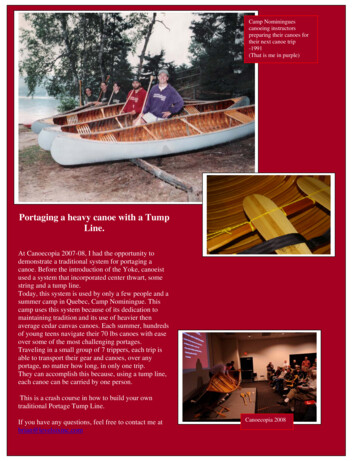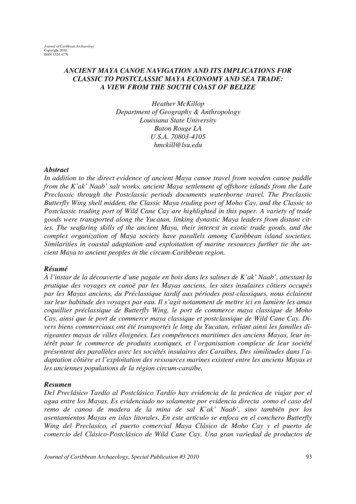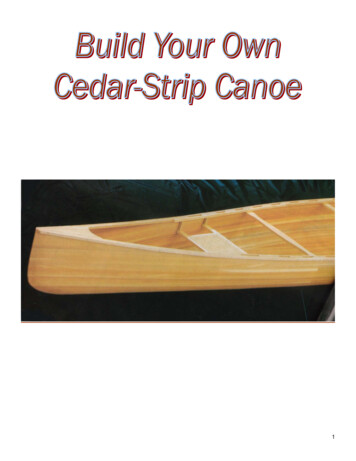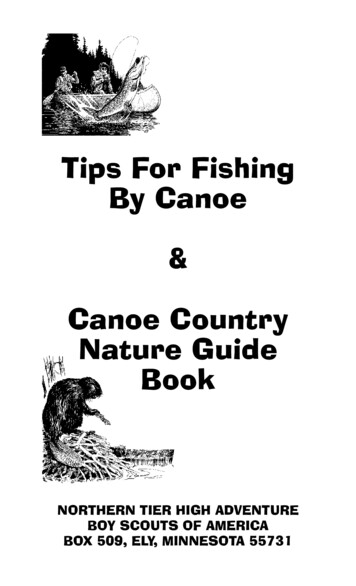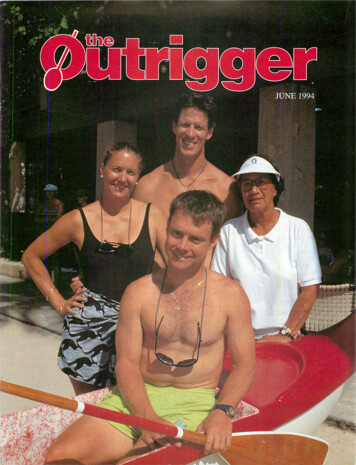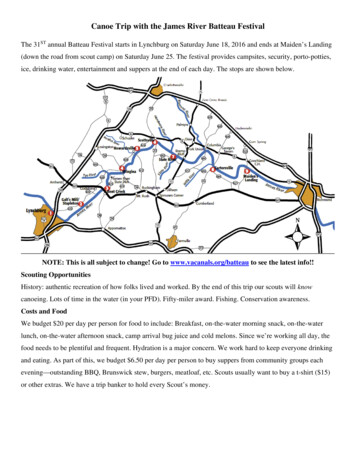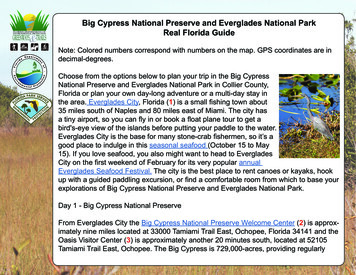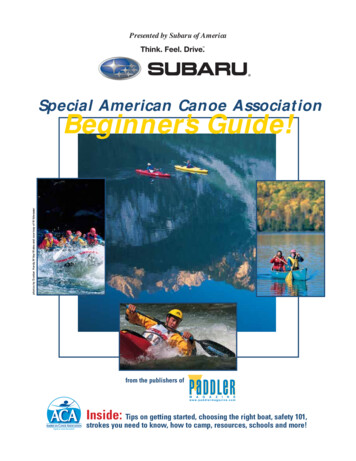
Transcription
Presented by Subaru of AmericaSpecial American Canoe Associationphotos by Dunbar Hardy, Wiley/Wales and courtesy of WildwasserBeginner’s Guide!from the publishers ofInside: Tips on getting started, choosing the right boat, safety 101,strokes you need to know, how to camp, resources, schools and more!
ACABeginner’s Guide!Specialelcome to the wonderful world of paddling! Those of us who have been at it for years know itto be a healthy, beautiful, rewarding experience and are happy to have more company on thewater.This Guide, put together by a group of dedicated paddlers, has useful tips on what kind of boatto start in, where to find instruction, what equipment to get, whom to paddle with—in fact, just abouteverything you need to get started.All of the authors are members of the American Canoe Association(ACA), and we actively promote it as the best organization of and for paddlers in all types of boats, onall types of water.The ACA has been around since 1880, making it the nation’s oldest waterway-basedconservation organization, and is involved in all forms of rafting, kayaking and canoeing. We put onevents and races all over the country; are deeply involved in conservation issues, access rights and publicpolicy; and teach thousands of folks like you the skills to safely and efficiently enjoy our nation’swaterways.You’ll find us quietly fishing on lakes, touring in the ocean, romping around on whitewater,and just enjoying a quiet float through the beauties of nature. In short, our paddling interests aredynamic and diverse, and we want to share them with you. So read through this Guide, get properlygeared up, sign up for some instruction and we’ll see you on the water!W3 Getting StartedChoosing a Boat7 Equipment 101From deciding between a canoe and kayak to assessingmaterials and making that paddling purchase, an insidelook at getting started in the wonderful world ofpaddlesports.by Becky MolinaPaddlesports Glossary by Becky MolinaEssential Equipment What you need to get started, whether you’re in a canoe,sea kayak or inflatable.10 SkillsSo You Want to Learn to Paddle? by Kent FordTake a lesson from an ACA-certified instructor! Plus, a sampling ofschools that can show you the ropes.Avoiding the Unexpected Plunge by Pam DillonSelf-rescue Skills: A Primer by Gordon BlackTips for Tandem Canoeing by Charlie and Diane Vasey-WilsonGetting There: Basic Paddling Skills by Becky MolinaCamping by Canoe or Kayak by Jackie PeppeTeaching Kids 101 by Bruce Lessels16 Resources to Get You StartedHow to Find More Information on Paddling by Gordon BlackWhere to Learn Morephoto by Scott UnderhillTableofContents
Getting StartedLetter From the U.S. Coast GuardDear New Paddler:You're just beginning to discover the thrill and freedom of paddlesports.the fun and relaxation of paddling a canoe orkayak through our nation's lakes, rivers and coastal waters. The United States Coast Guard wants you to enjoy your newpassion for a lifetime—and that's why your safety is so important to us. Our message is "You're in Command. Boat Safely."Just like the operators of larger powerboats or sailboats, you are in command of your boat. You're operationally and legallyresponsible for your safety and the safety of passengers and other boaters.Too many recreational paddlers assume they're safe because they're in small boats, in shallower water, or because they'regood swimmers. The fact is that more accidents occur among paddlers, hunters and anglers than among those who use theirboats primarily for cruising and other watersports. The good news is that a few simple steps greatly reduce your chances ofbeing involved in a paddling accident.First, wear your life jacket all the time. In 2001, nearly 600 people—80 percent of all recreational boating fatalities—drownedbecause they didn't have a life jacket on at the time of the accident. Good swimmers died. Boaters in shallow water died. Boatingaccidents happen too fast to reach for stowed life jackets—but you'll find that there are plenty of new, lightweight life jackets thatare easy and comfortable to wear while paddling. Second, take a boating course. Courses are available to fit all lifestyles, includingthe excellent classroom courses taught by certified American Canoe Association instructors, and the new America’s BoatingCourse, available online and on CD-ROM from the U.S. Coast Guard Auxiliary or United States Power Squadrons.Third, never boat under the influence. Alcohol plays a role in approximately one-third of all boating fatalities. Sun, windand motion on the water function as additional "stressors," increasing the effects of alcohol and even heightening the sideeffects of some prescription medications. Last, get a Vessel Safety Check (VSC) for your canoe or kayak every year. The U.S.Coast Guard Auxiliary and U.S. Power Squadrons offer this free check across the country. It's not just for big powerboats orsailboats-a VSC is the best way to discover safety problems or violations before they become dangerous on the water.The Coast Guard hopes you enjoy every minute of your time paddling your canoe or kayak. We also hope you'll doeverything you can to boat safely. Wear your life jacket, take a boating course, never boat under the influence, get a Vessel SafetyCheck and call (800) 368-5647 or visit www.uscgboating.org for more information. Remember, You're in Command. Boat Safely.Sincerely,photo courtesy of NOCScott Evans, Captain, U.S. Coast Guard; Chief, Office of Boating SafetyChoosing a Boatby Becky MolinaOis the bluest of planets, sprinkled with an array of waterways, from lakesand rivers to wetlands and the open sea. Launching upon these bluespots is an equally assorted array of paddlers—canoeists and kayakers with broadranging desires, family sizes, budgets, skills and commitment to the sport. Paddler’s 2003Buyer’s Guide lists more than 2,000 boat models in current production. How do youwade through such an inventory to pick the one that’s right for you? Here’s some helpto find the perfect match.OursBuying a BoatDon’t be afraid to enlist the help ofpaddlesport professionals—dealers,manufacturer’s representatives,instructors—they don’t just want yourmoney, they are dedicated to puttingmore safe and happy paddlers out onthe water.www.acanet.org Beginner’s Guide 3
CANOE OR KAYAK?You’ll find both craft on all of thewaterways mentioned above.There are canoesand kayaks designed for lakes and rivers, daytrips and weekend outings, expeditions andevery other type of scenario. But someenvironments, and some personalities, arebetter suited to a canoe than a kayak, and viceversa. Consider the familiar five W’s:Who,What,When,Where,Why, and the H: How.Who is going along? Alone, it’s easier toply a kayak in a straight line than it is a canoe.With a partner, tandem canoeing can be a joy.Canoes also have more space to carry the kidsand Fido down the river.What are you bringing with you? Thehigher volume of canoes makes them betterfor kitchen sink syndrome. Go ahead-bring thegrill, cooler and circus tent, but not in a kayak.Even if they did fit, gear is harder to load intokayak hatches than into open boats, where themain concern is weight distribution, not howto get your guitar through that little roundhole.When are you going? Kayaking is wetter,and thus potentially more chilly. Heads willlikely be doused in a spill. Not the best choicefor winter, perhaps, but kayaks are moreseaworthy, their low profile and decked topoffering protection from wind and waves.When a gale kicks up whitecaps, a kayak is lessapt to swamp.Where do you want to paddle? Inscenic narrow sloughs, you’d rather not have along kayak paddle constantly jousting withoverhead vegetation.Trips involving portagesdraw canoeists, as kayaks are heavier andtrickier to carry. Open water-be it oceancoastline or large lakes-calls strongly to seakayakers, whose boats can handle rougherconditions. In whitewater and surf, kayaks takeon waves, steep drops and holes without fillingup with water.Why are you doing this? For excitement,for exercise or for exotic experiences? Or toview wildlife, spend time with loved ones, orjust weekend fun? Canoes and kayaks can beused as vehicles to get from point to point, orsimply for lazy bird-watching jaunts.Thrilljunkies can get a buzz in either boat, butkayaks dominate the extreme fringes ofpaddlesport, where mastering the fundamentaltechniques requires lots of guided practice anda tolerance for water up the nose.And How ? How do you want to travel?The fastest, straightest-moving boats arekayaks, though it’s a mistake to think that allkayaks are faster than all canoes. How’s yourcomfort level? Kayaking is inherently wet, andadvancing in kayaking skills may mean facingfears of being upside down under water.Kayakers sit with their legs slightly bent infront of them, and without as much wiggleroom as their open-boat counterparts (canoesare better for afternoon naps). Canoeists cansit, but in most canoes you’re safer kneeling,especially when it’s windy or bouncy. Kneelingalso puts you higher off the water than sitting,lending to increased visibility. How big is yourTrying Before Buyingwallet? You’ll probably shell out more for akayak than for a canoe of comparableconstruction and quality. How’s your skill level?Or how committed are you to developing it? Anovice will move a kayak from A to B with lessfrustration than she would a canoe, but don’tbe fooled. Kayaking may be more beginnerfriendly, but both craft feature skill-intensivedisciplines that require expert instruction anddedicated practice to master.TYPES OF CANOES AND KAYAKSDesign determines performance, and thematerial used in canoe and kayak constructionaffects the cost, weight, durability and amountof upkeep needed.General Design ConsiderationsCanoes and kayaks have different shapesfor a reason. No one boat can do it all. Formfollows function, and the exact boat for you isthe one that best meets your intendedpurpose, size and skill level. Length can predict speed, all other factorsbeing equal.That is, if you take two boats oflike design, in the same conditions, with clonedpaddlers, the longer one will get there first.Thetradeoff? Maneuverability, in most cases. Asports car turns in a tighter radius than a semi. Rocker and tracking. Rocker is the amount of"smile" that you can see along the bottom of aboat, like the rail on a rocking chair. Morerocker (more upturned ends) means betterturning ability, at the expense of tracking, theability of a boat to hold a straight line.For best tracking, try a boat with very littlerocker (called straight or flat-keeled). But then,it’ll be harder to turn D Width.The wider the canoe or kayak, themore stable it will be—that is, when you firstenter it on quiet water, which is where most ofus try out a boat and many stay. Narrowerboats will seem tippier, but they will travelfaster. Ask your dealer. You may be able to test paddle different models, especially if you take a class or guided tour. Bottom shape contributes to stability andperformance in different conditions, so it’s notjust about width. Flat-bottomed hulls are morestable upon first entering,and will remain so as longas they are in quiet waterwith balanced paddlers onboard. Many recreationalpaddle craft have flatbottoms for this reason,but they’re not so stablein wind and waves.o you buy shoes or clothing without trying it on? Probably not.You’ll travel many happymiles in your canoe or kayak. Using the strategies below is like making that all-importantvisit to the fitting room. Take a class first. The more skill and knowledge you have, the better you’ll appreciate the differences in performance betweenmodels. Join a paddling club. Make friends with other paddlers, learn from their experiences, then ask to sample their gear. Rent before you buy. Rent often—at shops, local parks and liveries—and try as many different boats as you can. Attend paddlesport events. Local and regional festivals, symposia,classes and manufacturer demo days are terrific learningopportunities for beginning paddlers. You can try many differentmodels, take instructional clinics, attend seminars, see expertpaddling demonstrations and find discounts on gear.Bringing It HomeWhen you’re ready to own your first canoe orkayak: Visit your local paddlesport shop. Choose a reputable retailer witha wide variety of models on display and a knowledgeable, experienced staff. Do some research. The Buyer’s Guide issues of paddlesport magazines are helpful sources of information, as are product cataloguesavailable from dealers and manufacturers, and manufacturer Web sites. Establish a budget, then don’t spend it all on the boat. Don’t forget a PFD, paddle and other accessories necessary to yoursafety, comfort and pleasure on the water. While higher-priced boats aren’t always the best option, in general you get what you payfor.Beginner’s Guide 4 Safety. A safe boat floats,even when fully swamped with water. Flotationsystems can be integral to the design—foamfilled tanks and seats, solid kayak bulkheads, ora buoyant layer sandwiched betweenthe inner and outer surfaces of the hullmaterial—
or added after manufacture, with foam orinflatable inserts. In some models, theconsumer must add flotation.CANOESSolo or Tandem? In every category ofcanoes, you can find boats built for one ortwo. If you cherish solitude or total control,soloing may be the way to go, and a fewlessons can ensure that you go the way youwant to go. It is easier to travel and to steerwith a paddler in each end, however, andtandem canoes are far more commonplace.They can be very lightweight, and your backwill not mind the increased cost, especiallyafter a long carry.These canoes are morefragile and thus less common on whitewater. Aluminum is quite durable and resistant toultraviolet rays. It’s heavy, though, and designfeatures are limited by the nature of thematerial. Other less common materials used incanoes include wood in a variety ofconstructions, and fabric skin stretched over askeleton-like frame.KAYAKSThere are canoes andkayaks designed for lakesand rivers, day trips andweekend outings,expeditions, and everyother type of scenario.Types of Canoes General recreation.This is the canoe youpaddled at summer camp, and the one yourented last Saturday. Multi-purpose and usuallytandem, they range from 15 to 18 feet inlength and, in skilled hands, can turn and gostraight reasonably well. Tripping or touring. Solo trippers can befrom 13 to 17 feet long, while tandems topout at about 20.Tripping canoes have lessrocker and are built for travel, usually on calmwater, but some also handle moving rivers andbig lakes if the canoeists are well-practiced. Other specialized canoes include whitewatercanoes, which are short, deep and highlyrockered; solo sport canoes, which are usedfor non-destination, quietwater "play"; anddifferent kinds of racing canoes.Materials Used in CanoeConstruction Plastic, including the brand name Royalex, isinexpensive and impact-resistant, but it’sheavy and less able to hold a fine design line. Composite, or laminated, canoes are builtfrom fiberglass, Kevlar, carbon fiber or somecombination layered with synthetic glues.Fit. A favorite kayak is like a favorite pairof jeans. Not only should the size of boat andbody match, the cockpit should fit the paddlerat all points of contact.You can easilycustomize your outfitting for optimal comfort.Single or Double.The healthy majority ofkayaks are meant for one.Those for twocalled double or tandem kayaks-are useful onlong trips or for paddling with a child.Types of Kayaks Recreational.The most ubiquitous and oftenthe first choice for beginners, recreational, or"rec," boats are normally 10 to 15 feet longand 24 to 30 inches wide with flat bottoms.They often have very large cockpits, and siton-top models have no cockpit at all (but notall sit-on-tops are recreational kayaks).Themost affordable of kayaks, they are meant forcalm-water trips ranging from a few minutesto a few days. Sit-on-tops are especiallysuitable for beginners as there is no need tolearn the Eskimo roll; if you tip over, simplyclimb back on. Touring. As kayaks get longer (14-20 feet)and narrower (20-25 inches), they get faster.The line between touring and recreation typesblurs: Some are classified as "hybrids" or "lighttouring" and are appropriate for shorter tripson inland waterways. Sea kayaks are on thelonger, narrower end of the touring spectrum,with many features that allow for safe travel inopen water, including bulkheads for flotationand cockpits that accommodate spray skirts. Whitewater.Today’s most commonwhitewater kayaks are 6 to 9 feet long, 23 to26 inches wide, and highly rockered, with flatbottoms and flat sides. As with sea kayaks, aspray skirt keeps water out of the cockpit.Whitewater kayaks are also one type used forsurfing. Other specialized kayaks are made forsurfing, racing and for folding up into abackpack that can pose as checked baggage orbe stored in a closet.Materials Used in KayakConstruction Plastics, usually thin-walled polyethylene, areabundant in kayak construction. It is the leastexpensive, most durable and most impactresistant of kayak materials, seen in manywhitewater and recreational models. Composites like fiberglass, carbon fiber andKevlar make stiffer, lighter kayaks that costmore than plastic ones.The layers of cloth canbe shaped into very fine lines, and thesematerials are used primarily for higher-endtouring kayaks. Other less common materials include wood,and skin stretched over a wood or tubularaluminum frame. Inflatable kayaks are made ofa variety of air-retentive fabrics with syntheticcoatings.—Becky Molina is an ACA Instructor Trainerin kayaking and canoeing. She is a frequentpresenter at paddlesport events around thecountry and has contributed to two books, severalarticles and four instructional videos.JoinAmerican Canoe AssociationtheToday!For just 40 per year you’ll help protect ournation’s waterways, promote safety, education andinstruction, and become part of the country’s oldestwaterway-based conservation organization. Plus, you’llreceive a year’s subscription to Paddlermagazine absolutely Free!Call 703.451.0141 or visit www.acanet.org7432 Alban Station Boulevard, Suite B 232, Springfield, VA 22150www.acanet.org 703-451-0141www.acanet.org Beginner’s Guide 5
Getting StartedPaddling Is for EveryonePeople with disabilities enjoy time on the waterDoyou or a friend have back pain, arthritis in the hands or a more limiting loss of function?With some planning and adaptation, paddling is still possible.The first step is to identifyyour abilities and limit or loss of function.There are ways to compensate and keep on paddling.photo by G. Lais/courtesy Wilderness InquiryThe type of equipment you select makes a difference. Different kayaks offer different seating options, including angle-adjustableback rests; lightweight paddles decrease fatigue; a longerpaddle may allow a less tiring stroke; a break-apart paddleallows the blade angle to be changed if your wrist tires;lightweight boats and carts aid in moving the craft; tandemoptions provide more paddling opportunities for thosewho fatigue quickly or have some loss of upper-bodyfunction.Though paddling does involve the whole body,adaptations can compensate for loss of function. Forexample, if your back fatigues quickly, a number ofdifferent back rests can be attached to a canoe seat. In akayak, slipping a knee roll (a simple roll of closed-cellfoam) under your knees can maintain a slight bend to helprelax back muscles. Can’t grasp the paddle for longperiods of time? A hand grip can be created from bikeinner tubes and cable ties, allowing the paddler to holdOutfitters like Wilderness Inquir y help paddlers of all abilitiesthe paddle lightly and even flex fingers, without puttingenjoy time on the water.down the paddle.These and many other adaptations are detailed in the ACA manual, Canoeing and Kayaking for Persons With Disabilities. Themanual includes information on the full range of disabilities and their implications for paddling, equipment and adaptations,accessibility, safety and risk, and a host of teaching suggestions and guidelines for instructors. Contact the ACA for specificallytailored information and assistance to meet the needs of anyone with a disability who wants to paddle.You’ll be glad you did.—Janet ZellerTo Kayak orCanoe? HowDo I Choose?Opinions from Two ProsCanoeing and kayaking both havetheir own rewards. Below are threethings to consider when decidingbetween the crafts.1. How and where are you going to paddle? Deciding whether to canoe or kayak is sort of like choosing a car. Doyou need a family car, a car that gets good mileage or one that can carry a lot of firewood? It all depends on whatyou’re going to be doing. If you’re going to be paddling rivers or lakes, carrying a lot of gear, having to portagefrequently or possibly fishing, then a canoe is probably the craft of choice. If you’re going to be paddling great distancesin unprotected waters with winds and waves, or in a surf or ocean environment, then a kayak is probably your bestbet. If you’re mostly going to be paddling on small lakes, protected coves or inlets, then either would do. Pick the craftthat will cover most of your needs and desires. You can always rent a boat for that occasional odd journey.2. Physically, how do you feel in the boat? We all come with different sizes, shapes, physical abilities and limitations.Before deciding on one type of paddling over the other, take a class or two, join a club or attend a canoe/kayak demoday at a nearby dealer. This way you’ll be able to develop skills, gather information, try out a lot of different boats andsee how it feels physically to paddle them. Some people like the close feeling of being one with their boat that kayakingoffers, while others like the sitting position of the canoe because it allows them more freedom. Try and then decide.3. What is your gut telling you? Some people like country music, some like jazz, some both. There’s no right orwrong, just a preference. The same thing with paddling. There are canoe people, there are kayak people, and thenthere are those of us who want to do it all. Pay attention to the feeling you get when you are in a canoe or kayak.As you go through this process try to keep an open mind, listen to others, but then make your own decision. Remember,that with time, your skills and desires may change. Just go with the flow and remember it is alright to have morethan one boat. I do.—Bob Foote is an open canoe instructor trainer educator, basic coastal kayak instructor and freestyleinstructor for the ACA. He teaches canoeing and kayaking throughout North America and Europe. Info:www.bobfoote.com.Karen KnightI asked myself this same question when I was looking to get into paddling.I had tried canoeing in a college class years earlier and as I contemplated thequestion (canoe or kayak?) memories from the class came rushing back to me.Memories of me and my tandem partner losing our balance and dumping intothe cold New England river and memories of being frustrated as we hopelesslypaddled in circles, unable to make the canoe go straight. With those experiencesstill fresh in my mind, it didn’t take long for me to decide that I wanted a boatthat would be relatively easier to paddle and make go straight, one that I couldpaddle myself and would be suitable for trips along the coast of Maine where Ilived. I wanted a kayak. For years I enjoyed kayaking, but over time, I discoveredI enjoyed other types of paddling and a kayak wasn’t always the "best tool forthe job." Eventually, I took up canoeing and this craft has brought me the bestof both worlds. Nowadays it’s hard for me decide on whether to canoe or kayak.—Former World Freestyle Canoe Champion Karen Knight is an ACAInstructor Trainer who teaches paddling skills throughout the world.Bob FooteWhen I first got into paddling some 30 years ago, I didn’t have to ponderthe question on whether to canoe or kayak. I knew from the start that I wantedto paddle rivers and I wanted to do it in a canoe. I liked the challenge ofpaddling a canoe, its diversity, the space it offered for carrying gear, pluskneeling in a canoe just felt better on my back than sitting in a kayak. I havecanoed on rivers and lakes all over the world, but a few years ago, I startedto paddle more on the ocean, where I found a kayak the way to go. One ofthe main things to consider: determine how and where you are going to paddlemost of the time.
Equipment 101Paddlesports Glossaryby Becky MolinaBasic TerminologyBladeThe broad part at the end of a paddleBowThe forward end of a canoe or kayakHullThe bottom shape of a boat, which determines how it willperform in various conditions. Canoes have a hull only; kayakshave a hull on the bottom and a deck on topPFDPersonal flotation device, or lifejacket. In the U.S., PFDs mustbe approved by the Coast Guard. Wear it!ShaftThe long skinny part of a canoe or kayak paddleSternThe rear end of a canoe or kayakSwampTo fill (a boat) with waterTrimThe bow-to-stern leveling of a canoe or kayak that affectsboat control. In most cases it should be nearly level, with thestern slightly lower in the waterCanoeingGripThe part of a canoe paddle above the shaft, where the upperhand grips the paddle. Grips can be shaped like a “T” or likea pear or a small footballGunwaleUsually made of wood, vinyl or aluminum, gunwales(pronounced “gunnels”) run along the top edge of a canoehull, stiffening and helping the hull hold its shapePainterA rope tied to either end of a canoe for rescue andanchoring to shorePortageTo carry a canoe over land (or the trail you carry it over) toget from one waterway to another or avoid a rapidThwartCross pieces in a canoe, thwarts go from gunwale to gunwaleand help the boat hold its shape. Seats function as thwarts,too, and some thwarts are appropriately spaced andconstructed for kneeling on the bottom of the canoeKayakingBack band (back rest)Provides support for the lower back while kayaking and helpswith erect posture in the boat. Located behind the seat, andusually made of padded fabric, plastic or foamBulkheadA cross-sectional wall inside a kayak, made of composite,plastic or foam. Bulkheads provide structural support andcross-sectional bulkheads create watertight compartments forbuoyancy and storageCockpitThe enclosed central compartment of a kayak, in which thepaddler sitsDeckThe top part of a kayak that keeps the hull from filling withwaterFoot pegs/bulkhead(also known as foot braces) Adjustable structures inside thecockpit on which a kayaker places the balls of her feetRollThe technique of righting a capsized kayak while still insideSit-on-top (SOT)A kayak without a cockpit, sit-on-tops are usually self-bailingwith various seat and foot brace configurations. Many are forrecreational use, but some are designed for touring andracingSpray skirtA neoprene or nylon skirt worn by a kayaker that attachesto the rim (coaming) of the cockpit to keep water outThigh (knee) bracesUsually found in whitewater and touring kayaks, thesestructures inside the cockpit give the paddler important pointsof contact for boat controlWet exitComing out of a capsized kayakEssential EquipmentGear for getting goingYour gear carries you out and home, protects you from the elements and assists you in emergencies. All of it should be in goodcondition and fit your body, skill level and setting. Putting a child in an adult PFD isn’t a smart idea, for example, nor is using thatleaky, beater kayak you borrowed at the last minute from your sister’s boyfriend. Make sure the gear is right before you start becauseonce out on the water, it may be too late.The Must HavesDon’t launch unless you have these items A PERSONAL FLOTATION DEVICE. It’s widely held thathumans have difficulty breathing underwater. Be sure your PFD fits, andwear it properly and religiously.The overwhelming majority of seriousaccidents (deaths and close calls) in paddlesports occur when paddlersare not wearing a Coast Guard-approved PFD. A PADDLE. Though the boat may seem the most elemental piece ofequipment, it’s the paddle that connects your muscle motor to thewater. Consider these features:Design. Different paddles are made for each discipline ofpaddlesport.The best one for a lazy family river trip may not handle along-distance race.Length. Kayak paddles are usually measured in centimeters, withtouring ones longer than those for whitewater. Canoe paddles usuallycome with overall length in inches, but some specialists prefer to useshaft length alone as the main indicator in matching a paddle to aperson.Your boat width affects paddle size, too.Blade size.The bigger the blade, the more work you’ll do witheach stroke. Racers use low surface-area blades so they can stroke at ahigh rate of repetition without stress injury. Larger blades are bettersuited to a slower cadence.Material. Plastic and aluminum paddles are everywhere.They areinexpensive, durable and low-maintenance.Wood is prized for itsbeauty and warmth but can vary greatly in weight, strength, cost andsymmetry, and requires attentive upkeep. Fiberglass and carbon fibermake for pricey, stiff and super-lightweight high-performance paddles. A BUDDY. Beginning canoeists and kayakers should never paddlealone.There’s safety in numbers, especially when someone needs to gofor help in an emergency.www.acanet.org Beginner’s Guide 7
Dressing the PartLooking cool is one matter, being too cool is another. Becauseimmersion is a major cause of hypothermia, dress for it.When the sumof air and water temperatures is below 120 degrees, check outspecialized paddling wear like wet suits, dry suits, and the large varietyof fuzzy, rubbery apparel available.Think in layers. Layers trap air (whichprovides insulation) and allow for personal climate control. Syntheticmaterials dry quickly, wick moisture away from the body and re
Special American Canoe Association Beginner’s Guide! Inside: Tips on getting started, choosing the right boat, safety 101, strokes you need to know, how to camp, resources, schools and more! phot
